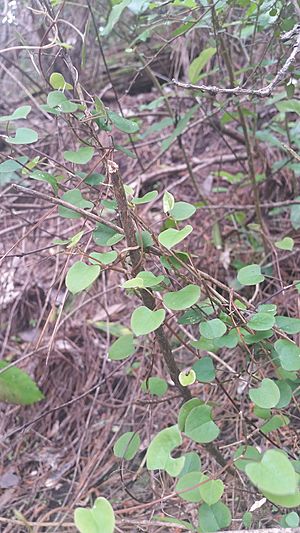Large-leaved muehlenbeckia facts for kids
Quick facts for kids Large-leaved muehlenbeckia |
|
|---|---|
 |
|
| Scientific classification | |
| Genus: |
Muehlenbeckia
|
| Species: |
australis
|
| Synonyms | |
|
|
Muehlenbeckia australis, also known as the large-leaved muehlenbeckia or pohuehue, is a special climbing plant. It grows naturally in New Zealand. This plant can either spread along the ground or climb high up other plants and structures.
Contents
Meet the Pohuehue Plant
The pohuehue plant can grow very tall, sometimes reaching up to 10 meters (about 33 feet). It has bark that is grey in color. Its leaves grow on stiff stalks called petioles. These petioles are about 25 millimeters (1 inch) long.
The main part of the leaf, called the lamina, is usually 2 to 8 centimeters (about 1 to 3 inches) long. It is also 1 to 3 centimeters (about 0.4 to 1.2 inches) wide. Interestingly, this plant has different leaf shapes when it is young compared to when it is fully grown. It also loses its leaves in winter, just like some trees.
Flowers and Fruits
The flowers of the pohuehue are greenish. They bloom from late spring all the way through autumn. Sometimes, the flowers grow in clusters called panicles, especially in spring and summer.
After the flowers, the plant produces juicy fruits. These fruits have shiny black seeds. The seeds are covered by a white, soft cup. This cup is made from parts of the flower called sepals. Many different birds and lizards enjoy eating these fruits. You can usually find fruits on the plant from November to April, and sometimes even until June.
How Pohuehue Got Its Name
The Muehlenbeckia australis plant was first described in 1786. A scientist named Georg Forster gave it the name Coccoloba australis. Later, in 1841, another scientist named Carl Meissner moved it to a different group of plants. This new group was called Muehlenbeckia.
Sometimes, you might see another plant called Muehlenbeckia adpressa. Some plant experts think this is actually the same species as Muehlenbeckia australis. However, other experts believe they are two different kinds of plants. It is a bit of a puzzle for scientists!
Pohuehue in Nature
Muehlenbeckia australis loves places where it can get lots of sunlight. It also needs something to climb on. You can often find it growing at the edges of forests or on cliff faces. It also thrives in areas with scrub or where new plants are growing back.
This plant grows very quickly and loves to climb. It can even grow over trees along roadsides. Pohuehue has actually done very well since people started settling in New Zealand. It often grows in cleared areas. Sometimes, it is the only native plant left in these spots.
Pohuehue and Moths
The Muehlenbeckia australis plant is very important for a special moth. This moth is called Pyrgotis eudorana. It is a native New Zealand moth. The pohuehue plant is the only plant this moth uses as a host. This means the moth's caterpillars eat the leaves of the pohuehue.

